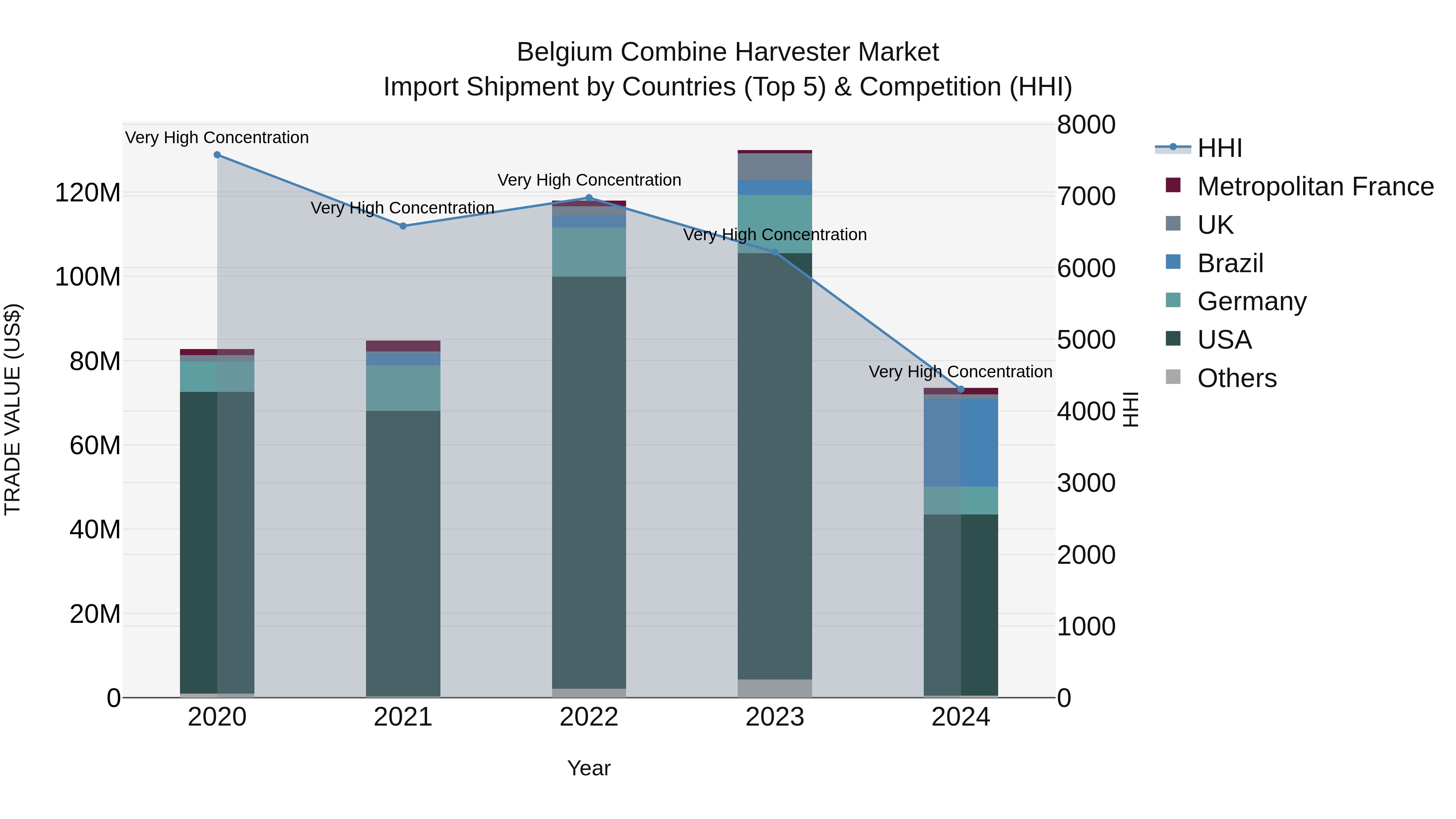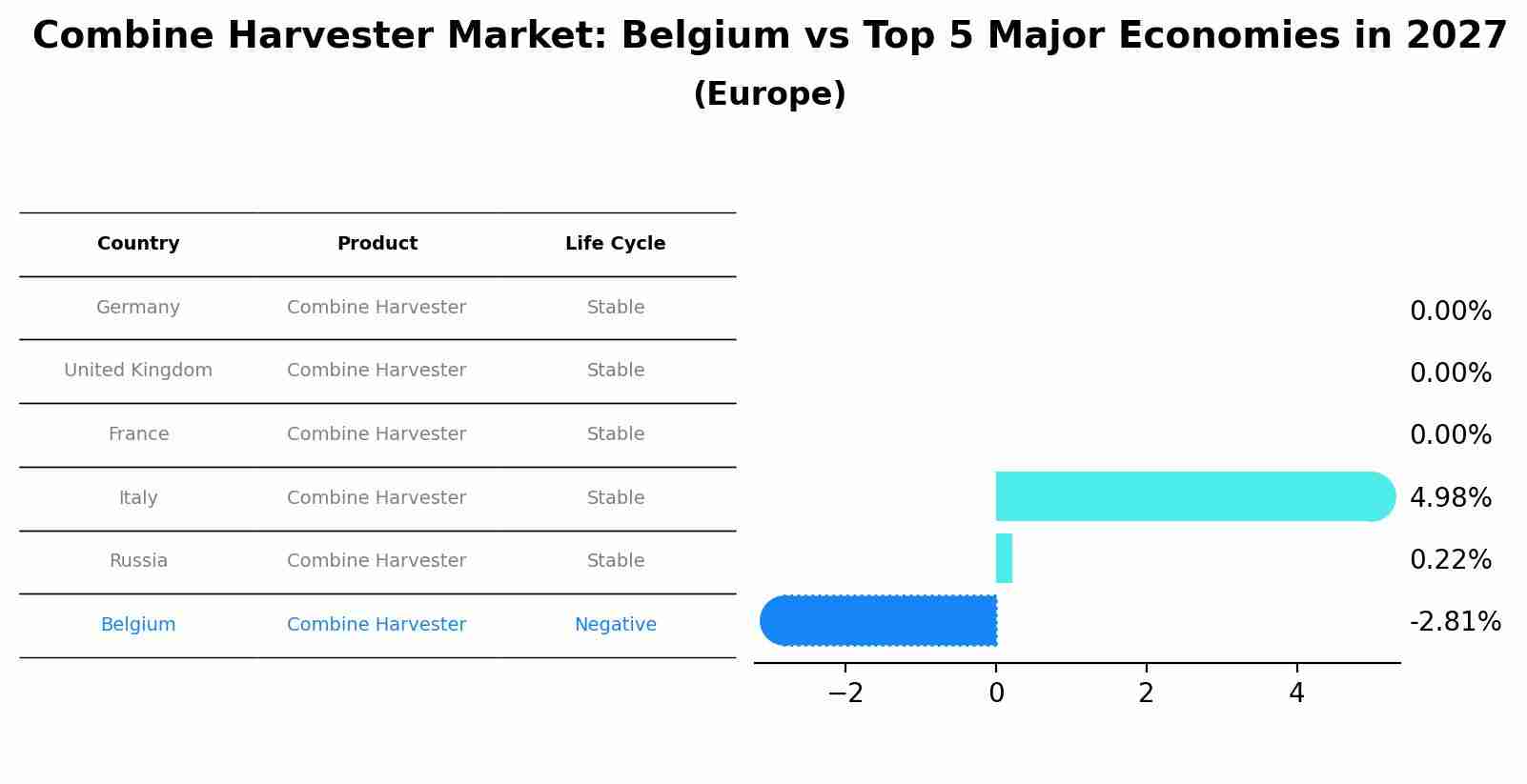Belgium Combine Harvester Market (2025-2031) | Segmentation, Forecast, Share, Growth, Outlook, Analysis, Industry, Trends, Companies, Size, Value & Revenue
| Product Code: ETC5398207 | Publication Date: Nov 2023 | Updated Date: Oct 2025 | Product Type: Market Research Report | |
| Publisher: 6Wresearch | Author: Bhawna Singh | No. of Pages: 60 | No. of Figures: 30 | No. of Tables: 5 |
Belgium Combine Harvester Market Top 5 Importing Countries and Market Competition (HHI) Analysis
In 2024, Belgium continued to rely heavily on key exporters such as the USA, Brazil, Germany, Metropolitan France, and the UK for its combine harvester imports. Despite a concerning high concentration with a high Herfindahl-Hirschman Index (HHI), the market experienced a significant decline in both the Compound Annual Growth Rate (CAGR) from 2020 to 2024 at -2.9% and the growth rate from 2023 to 2024 at -43.4%. These figures suggest a challenging environment for combine harvester imports in Belgium, signaling potential shifts in market dynamics and demand patterns.

Combine Harvester Market: Belgium vs Top 5 Major Economies in 2027 (Europe)
By 2027, the Combine Harvester market in Belgium is anticipated to reach a growth rate of -2.81%, as part of an increasingly competitive Europe region, where Germany remains at the forefront, supported by United Kingdom, France, Italy and Russia, driving innovations and market adoption across sectors.

Belgium Combine Harvester Market Overview
The Belgium Combine Harvester Market is supported by the country`s agricultural sector`s need for efficient and advanced farming equipment. Combine harvesters improve productivity by combining multiple harvesting operations into a single process. Technological advancements, such as precision farming and automation, are key trends in this market.
Drivers of the market
The Belgium combine harvester market is driven by the agricultural sector`s need to improve productivity and efficiency. The demand for advanced farming equipment that can perform multiple functions, such as harvesting, threshing, and cleaning, in a single operation is increasing. Additionally, the trend towards mechanization in agriculture to address labor shortages and enhance crop yield supports market growth. Technological advancements, such as GPS and IoT-enabled harvesters, also drive adoption by providing farmers with precision farming capabilities.
Challenges of the market
The Belgium combine harvester market is challenged by factors such as technological advancements and fluctuating agricultural conditions. The need for continuous innovation to improve efficiency, productivity, and fuel consumption drives research and development efforts. Additionally, variations in weather conditions and crop yields can impact the demand for combine harvesters, leading to market volatility. The market also faces pressure from environmental regulations aimed at reducing emissions and promoting sustainable agricultural practices, requiring manufacturers to adapt their designs accordingly. Moreover, competition from both local and international manufacturers necessitates that companies offer high-performance and cost-effective solutions to attract buyers.
Government Policy of the market
The combine harvester market in Belgium is supported by agricultural policies that promote modernization and efficiency in farming practices. The government provides subsidies and incentives for farmers to invest in advanced agricultural machinery, including combine harvesters. Additionally, EU regulations on emissions and safety standards for agricultural machinery impact the market, ensuring that equipment used is environmentally friendly and safe for operators.
Key Highlights of the Report:
- Belgium Combine Harvester Market Outlook
- Market Size of Belgium Combine Harvester Market, 2024
- Forecast of Belgium Combine Harvester Market, 2031
- Historical Data and Forecast of Belgium Combine Harvester Revenues & Volume for the Period 2021-2031
- Belgium Combine Harvester Market Trend Evolution
- Belgium Combine Harvester Market Drivers and Challenges
- Belgium Combine Harvester Price Trends
- Belgium Combine Harvester Porter`s Five Forces
- Belgium Combine Harvester Industry Life Cycle
- Historical Data and Forecast of Belgium Combine Harvester Market Revenues & Volume By Cutting Width for the Period 2021-2031
- Historical Data and Forecast of Belgium Combine Harvester Market Revenues & Volume By Small Size Combine Harvester for the Period 2021-2031
- Historical Data and Forecast of Belgium Combine Harvester Market Revenues & Volume By Large Size Combine Harvester for the Period 2021-2031
- Historical Data and Forecast of Belgium Combine Harvester Market Revenues & Volume By Type for the Period 2021-2031
- Historical Data and Forecast of Belgium Combine Harvester Market Revenues & Volume By Wheel Type Combine Harvester for the Period 2021-2031
- Historical Data and Forecast of Belgium Combine Harvester Market Revenues & Volume By Crawler Type Combine Harvester for the Period 2021-2031
- Historical Data and Forecast of Belgium Combine Harvester Market Revenues & Volume By Power Source for the Period 2021-2031
- Historical Data and Forecast of Belgium Combine Harvester Market Revenues & Volume By Tractor Pulled/PTO Powered Combine Harvester for the Period 2021-2031
- Historical Data and Forecast of Belgium Combine Harvester Market Revenues & Volume By Self-Propelled Combine Harvester for the Period 2021-2031
- Belgium Combine Harvester Import Export Trade Statistics
- Market Opportunity Assessment By Cutting Width
- Market Opportunity Assessment By Type
- Market Opportunity Assessment By Power Source
- Belgium Combine Harvester Top Companies Market Share
- Belgium Combine Harvester Competitive Benchmarking By Technical and Operational Parameters
- Belgium Combine Harvester Company Profiles
- Belgium Combine Harvester Key Strategic Recommendations
Frequently Asked Questions About the Market Study (FAQs):
1 Executive Summary |
2 Introduction |
2.1 Key Highlights of the Report |
2.2 Report Description |
2.3 Market Scope & Segmentation |
2.4 Research Methodology |
2.5 Assumptions |
3 Belgium Combine Harvester Market Overview |
3.1 Belgium Country Macro Economic Indicators |
3.2 Belgium Combine Harvester Market Revenues & Volume, 2021 & 2031F |
3.3 Belgium Combine Harvester Market - Industry Life Cycle |
3.4 Belgium Combine Harvester Market - Porter's Five Forces |
3.5 Belgium Combine Harvester Market Revenues & Volume Share, By Cutting Width, 2021 & 2031F |
3.6 Belgium Combine Harvester Market Revenues & Volume Share, By Type, 2021 & 2031F |
3.7 Belgium Combine Harvester Market Revenues & Volume Share, By Power Source, 2021 & 2031F |
4 Belgium Combine Harvester Market Dynamics |
4.1 Impact Analysis |
4.2 Market Drivers |
4.2.1 Increasing demand for advanced farming equipment for higher efficiency and productivity |
4.2.2 Government subsidies and support for agriculture sector |
4.2.3 Growing adoption of precision farming techniques in Belgium |
4.3 Market Restraints |
4.3.1 High initial investment cost for purchasing combine harvesters |
4.3.2 Dependence on external factors like weather conditions affecting agricultural output |
5 Belgium Combine Harvester Market Trends |
6 Belgium Combine Harvester Market Segmentations |
6.1 Belgium Combine Harvester Market, By Cutting Width |
6.1.1 Overview and Analysis |
6.1.2 Belgium Combine Harvester Market Revenues & Volume, By Small Size Combine Harvester, 2021-2031F |
6.1.3 Belgium Combine Harvester Market Revenues & Volume, By Large Size Combine Harvester, 2021-2031F |
6.2 Belgium Combine Harvester Market, By Type |
6.2.1 Overview and Analysis |
6.2.2 Belgium Combine Harvester Market Revenues & Volume, By Wheel Type Combine Harvester, 2021-2031F |
6.2.3 Belgium Combine Harvester Market Revenues & Volume, By Crawler Type Combine Harvester, 2021-2031F |
6.3 Belgium Combine Harvester Market, By Power Source |
6.3.1 Overview and Analysis |
6.3.2 Belgium Combine Harvester Market Revenues & Volume, By Tractor Pulled/PTO Powered Combine Harvester, 2021-2031F |
6.3.3 Belgium Combine Harvester Market Revenues & Volume, By Self-Propelled Combine Harvester, 2021-2031F |
7 Belgium Combine Harvester Market Import-Export Trade Statistics |
7.1 Belgium Combine Harvester Market Export to Major Countries |
7.2 Belgium Combine Harvester Market Imports from Major Countries |
8 Belgium Combine Harvester Market Key Performance Indicators |
8.1 Average age of combine harvesters in use |
8.2 Adoption rate of precision farming technologies |
8.3 Percentage of agricultural land using modern farming equipment |
8.4 Efficiency improvement in harvesting process |
8.5 Maintenance cost reduction over time |
9 Belgium Combine Harvester Market - Opportunity Assessment |
9.1 Belgium Combine Harvester Market Opportunity Assessment, By Cutting Width, 2021 & 2031F |
9.2 Belgium Combine Harvester Market Opportunity Assessment, By Type, 2021 & 2031F |
9.3 Belgium Combine Harvester Market Opportunity Assessment, By Power Source, 2021 & 2031F |
10 Belgium Combine Harvester Market - Competitive Landscape |
10.1 Belgium Combine Harvester Market Revenue Share, By Companies, 2024 |
10.2 Belgium Combine Harvester Market Competitive Benchmarking, By Operating and Technical Parameters |
11 Company Profiles |
12 Recommendations | 13 Disclaimer |
- Single User License$ 1,995
- Department License$ 2,400
- Site License$ 3,120
- Global License$ 3,795
Search
Thought Leadership and Analyst Meet
Our Clients
Related Reports
- Germany Breakfast Food Market (2026-2032) | Industry, Share, Growth, Size, Companies, Value, Analysis, Revenue, Trends, Forecast & Outlook
- Australia Briquette Market (2025-2031) | Growth, Size, Revenue, Forecast, Analysis, Trends, Value, Share, Industry & Companies
- Vietnam System Integrator Market (2025-2031) | Size, Companies, Analysis, Industry, Value, Forecast, Growth, Trends, Revenue & Share
- ASEAN and Thailand Brain Health Supplements Market (2025-2031) | Strategy, Consumer Insights, Analysis, Investment Trends, Opportunities, Growth, Size, Share, Industry, Revenue, Segments, Value, Segmentation, Supply, Forecast, Restraints, Outlook, Competition, Drivers, Trends, Demand, Pricing Analysis, Competitive, Strategic Insights, Companies, Challenges
- ASEAN Bearings Market (2025-2031) | Strategy, Consumer Insights, Analysis, Investment Trends, Opportunities, Growth, Size, Share, Industry, Revenue, Segments, Value, Segmentation, Supply, Forecast, Restraints, Outlook, Competition, Drivers, Trends, Demand, Pricing Analysis, Competitive, Strategic Insights, Companies, Challenges
- Europe Flooring Market (2025-2031) | Outlook, Share, Industry, Trends, Forecast, Companies, Revenue, Size, Analysis, Growth & Value
- Saudi Arabia Manlift Market (2025-2031) | Outlook, Size, Growth, Trends, Companies, Industry, Revenue, Value, Share, Forecast & Analysis
- Uganda Excavator, Crane, and Wheel Loaders Market (2025-2031) | Strategy, Consumer Insights, Analysis, Investment Trends, Opportunities, Growth, Size, Share, Industry, Revenue, Segments, Value, Segmentation, Supply, Forecast, Restraints, Outlook, Competition, Drivers, Trends, Demand, Pricing Analysis, Competitive, Strategic Insights, Companies, Challenges
- Rwanda Excavator, Crane, and Wheel Loaders Market (2025-2031) | Strategy, Consumer Insights, Analysis, Investment Trends, Opportunities, Growth, Size, Share, Industry, Revenue, Segments, Value, Segmentation, Supply, Forecast, Restraints, Outlook, Competition, Drivers, Trends, Demand, Pricing Analysis, Competitive, Strategic Insights, Companies, Challenges
- Kenya Excavator, Crane, and Wheel Loaders Market (2025-2031) | Strategy, Consumer Insights, Analysis, Investment Trends, Opportunities, Growth, Size, Share, Industry, Revenue, Segments, Value, Segmentation, Supply, Forecast, Restraints, Outlook, Competition, Drivers, Trends, Demand, Pricing Analysis, Competitive, Strategic Insights, Companies, Challenges
Industry Events and Analyst Meet
Whitepaper
- Middle East & Africa Commercial Security Market Click here to view more.
- Middle East & Africa Fire Safety Systems & Equipment Market Click here to view more.
- GCC Drone Market Click here to view more.
- Middle East Lighting Fixture Market Click here to view more.
- GCC Physical & Perimeter Security Market Click here to view more.
6WResearch In News
- Doha a strategic location for EV manufacturing hub: IPA Qatar
- Demand for luxury TVs surging in the GCC, says Samsung
- Empowering Growth: The Thriving Journey of Bangladesh’s Cable Industry
- Demand for luxury TVs surging in the GCC, says Samsung
- Video call with a traditional healer? Once unthinkable, it’s now common in South Africa
- Intelligent Buildings To Smooth GCC’s Path To Net Zero


















